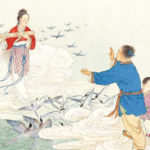The name Thất Tịch may sound unfamiliar to most Vietnamese, but if we mention the day when Ngưu Lang and Chức Nữ meet, it will surely ring a bell as everyone knows when this event takes place each year.
What is its origin? What is the significance of this day? Are there any taboos to be aware of on Thất Tịch? Let’s explore these questions together!
Related article:
1 What is Thất Tịch?
For many years, the 7th day of the 7th lunar month has been marked as Thất Tịch in several East Asian countries, including Vietnam and China. This festival, also known as the Qixi Festival, symbolizes love and is closely tied to the ancient tale of Ngưu Lang and Chức Nữ.
In Vietnam, we affectionately refer to Thất Tịch as the day of “ông Ngâu bà Ngâu”. This name stems from the belief that, on this day, Vietnam experiences the “mưa ngâu”—a rainfall believed to be the tears of joy shed by Ngưu Lang and Chức Nữ upon their annual reunion.
Related article:
 Thất Tịch falls on the 7th day of the 7th lunar month every year
Thất Tịch falls on the 7th day of the 7th lunar month every year
2 When is Thất Tịch in 2023?
Thất Tịch is observed on the 7th day of the 7th lunar month annually, which corresponds to August 22, 2022 (a Tuesday). Here are the dates for the upcoming years:
-
Thất tịch 2022: August 4, 2022
-
Thất tịch 2023: August 22, 2022
-
Thất tịch 2024: August 10, 2022
-
Thất tịch 2025: August 29, 2022
Related article: Are there any other festivals in the 7th lunar month?
3 Origin and Significance of Thất Tịch
Meaning of Thất Tịch in Vietnam
Thất Tịch originates from the love story of Ngưu Lang and Chức Nữ. This fairy tale, known as Ngưu Lang Chức Nữ in Chinese and Ông Ngâu Bà Ngâu in Vietnamese, has its roots in China and has since been retold with various adaptations.
 Illustration of the couple
Illustration of the couple
According to the Vietnamese version: The legend goes that Ngưu Lang, tasked by the Jade Emperor to herd cattle in heaven, fell in love with Chức Nữ, a talented weaver. Enchanted by her gentle nature and domestic skills, Ngưu Lang neglected his cattle, while Chức Nữ became distracted from her weaving by his enchanting flute playing.
The Jade Emperor, furious at their negligence, separated them, placing one at each end of the Milky Way. However, their unwavering love moved the Jade Emperor, who eventually allowed them to meet once a year on the 7th day of the 7th lunar month, with the help of a bridge formed by a flock of magpies.
The name ông Ngâu bà Ngâu stems from the belief that, upon their reunion, Ngưu Lang and Chức Nữ cried tears of joy, which fell to earth as the “mưa ngâu.” This rainfall is seen as a symbol of their reunion, and the day itself has come to represent love and devotion for couples in Eastern cultures.
Related article: What if it doesn’t rain on Thất Tịch?
Thất Tịch, also known as the day of ông Ngâu bà Ngâu, is not just about romantic love. It is also a day to pray for peace and prosperity, including wishes for a large family.
Meaning of Thất Tịch in China
In China, Thất Tịch, also known as Qixi, is considered a romantic festival. On this day, unmarried Chinese women traditionally pray for a skillful hand in needlework and a loving marriage, just like the story of Ngưu Lang and Chức Nữ.
This tradition dates back to the reign of Emperor Le Thanh Tong (1054 – 1072). Historical records show that, at the age of 42, the emperor prayed for a child at Ha Temple in Hanoi on the 7th day of the 7th lunar month. His prayers were answered, and he was blessed with a son, Crown Prince Can Duc.
Related article:
 Celebrating Thất Tịch in China
Celebrating Thất Tịch in China
Meaning of Thất Tịch in Japan
In Japan, Thất Tịch, known as Tanabata, commemorates the meeting of Orihime (Chức Cơ, or Vega) and Hikoboshi (Ngạn Tinh, or Altair). On this day, the Japanese visit shrines to pray for love and decorate bamboo branches with colorful streamers. They also write their wishes on tanzaku, rectangular strips of paper, and hang them on the bamboo, hoping for dexterity and a bountiful harvest.
 Thất Tịch customs in Japan
Thất Tịch customs in Japan
Meaning of Thất Tịch in Korea
In Korea, Thất Tịch is called Chilseok, and it holds a slightly different significance. The festival is seen as a time to wish for good health and abundant crops as it falls during the rainy season, marking the end of harsh, hot weather.
During Chilseok, Koreans bathe in the rain to pray for health, and the rain is believed to nourish the crops. As a result, vegetables like cucumbers and pumpkins are consumed in abundance during this period.
 Thất Tịch traditions in Korea
Thất Tịch traditions in Korea
Related article:
4 Customs and Traditions of Thất Tịch in Different Countries
Customs in Vietnam
On Thất Tịch, young Vietnamese couples often visit temples to pray for love and eat red beans, as they are considered a symbol of love and good luck in finding a partner. It is believed that eating red beans on Thất Tịch will bring singles their soulmates and ensure that couples stay together forever.
 Eating red bean desserts on Thất Tịch
Eating red bean desserts on Thất Tịch
Customs in China
In addition to praying to Chức Nữ for love and dexterity, Chinese women also engage in a unique custom on Thất Tịch: floating a needle on water. It is believed that if the needle stays afloat, the woman will possess intelligence and wisdom.
 Floating a needle on water
Floating a needle on water
Customs in Japan
During the Tanabata festival, the Japanese write their wishes on colorful rectangular paper strips (tanzaku) and hang them on bamboo branches, sometimes along with decorations. The colors used include green, pink, yellow, white, and black.
At the end of the festival, these bamboo branches with the tanzaku are taken down, placed on boats, and set adrift on rivers, or burned.
 Japanese customs during Thất Tịch
Japanese customs during Thất Tịch
Customs in Korea
In Korea: During the Chilseok festival, in addition to bathing in the rain, Koreans eat noodles, baked goods, and other wheat-based dishes because this is when wheat is at its most flavorful. If not consumed during Chilseok, the upcoming cold winds will ruin the taste of wheat.
 Eating noodles and baked goods during Thất Tịch
Eating noodles and baked goods during Thất Tịch
5 Dos and Don’ts on Thất Tịch
Thất Tịch holds deep spiritual significance, and according to folklore, there are certain taboos to be aware of if you wish for a smooth love life:
Avoid Weddings
Based on the tale of Ngưu Lang and Chức Nữ, the 7th day of the 7th lunar month is the only day they can be together after a year of separation. However, they can only be together for one day before parting again for another year. Therefore, it is considered unfortunate to hold weddings or engagements on this day.
 Avoid weddings on Thất Tịch
Avoid weddings on Thất Tịch
Avoid Construction
From a spiritual perspective, the 7th lunar month is considered the “month of wandering souls”, when ghosts and spirits are believed to roam freely. Therefore, it is considered inauspicious to build or renovate houses during this time, as it may lead to accidents or mistakes. Practically speaking, the “mưa ngâu” rainfall typical of this day also poses a challenge for construction work.
 Avoid construction on Thất Tịch
Avoid construction on Thất Tịch
Refrain from Evil Deeds
Not just on Thất Tịch but every day, doing good and avoiding evil is essential. However, on Thất Tịch, refraining from evil deeds is believed to bring peace and luck in love. It is also a way to make a good impression on your loved one.
Related article:
6 Quotes and Status Updates for Thất Tịch
1. Let’s forever cherish the mythical love story of Ngưu Lang and Chức Nữ, wishing them eternal happiness.
2. The sad rain of Thất Tịch seems to foreshadow a separation, just like in the tale of Ngưu Lang and Chức Nữ, where their love faces countless trials. The sky weeps to console and comfort them.
3. The 7th lunar month arrives with the sudden rain of Thất Tịch. Each droplet seems to carry the sorrow of a person’s story… Who came up with the name “mưa ngâu”? It sounds so melancholy.
4. Many associate the 7th lunar month with ghosts



































